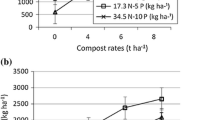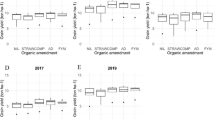Abstract
A transition period of at least 2 years is required for annual crops before the produce may be certified as organically grown. The purpose of this study was to evaluate the effects of three organic amendments on the yield and quality of wheat (Triticum aestivum L.) and on soil properties during transition to organic production. The organic amendments were composted farmyard manure (FYMC), vermicompost and lantana (Lantana spp. L.) compost applied to soil at four application rates (60 kg N ha−1, 90 kg N ha−1, 120 kg N ha−1 and 150 kg N ha−1). The grain yield of wheat in all the treatments involving organic amendments was markedly lower (36–65% and 23–54% less in the first and second year of transition, respectively) than with the mineral fertilizer treatment. For the organic treatments applied at equivalent N rates, grain yield was higher for FYMC treatment, closely followed by vermicompost. In the first year of transition, protein content of wheat grain was higher (85.9 g kg−1) for mineral fertilizer treatment, whereas, in the second year, there were no significant differences among the mineral fertilizer treatment and the highest application rate (150 kg N ha−1) of three organic amendments. The grain P and K contents were, however, significantly higher for the treatments involving organic amendments than their mineral fertilizer counterpart in both years. Application of organic amendments, irrespective of source and rate, greatly lowered bulk density (1.14–1.25 Mg m−3) and enhanced pH (6.0–6.5) and oxidizable organic carbon (13–18.8 g kg−1) of soil compared with mineral fertilizer treatment after a 2-year transition period. Mineral fertilized plots, however, had higher levels of available N and P than plots with organic amendments. All the treatments involving organic amendments, particularly at higher application rates, enhanced soil microbial activities of dehydrogenase, β-glucosidase, urease and phosphatase compared with the mineral fertilizer and unamended check treatments. We conclude that the application rate of 120 kg N ha−1 and 150 kg N ha−1 of all the three sources of organic amendments improved soil properties. There was, however, a 23–65% reduction in wheat yield during the 2 years of transition to organic production.



Similar content being viewed by others
References
AOAC (1990) Official methods of analysis, 15th edn. AOAC International. Arlington, VA
Arden-Clarke C, Hodges RD (1988) The environmental effects of conventional and organic/biological farming systems. II. Soil ecology, soil fertility, and nutrient cycles. Biol Agric Hortic 5:223–287
Casida LE, Klein D, Santoro T (1964) Soil dehydrogenase activity. Soil Sci 98:371–376
Castillo X, Joergensen RG (2001) Impact of ecological and conventional arable management systems on chemical and biological soil quality indices in Nicaragua. Soil Biol Biochem 33:1591–1597
Clark MS, Horwath WR, Shennan C et al (1998) Changes in soil chemical properties resulting form organic and low-input farming practices. Agron J 90:662–671
Delate K, Cambardella CA (2004) Agroecosystem performance during transition to certified organic grain production. Agron J 96:1288–1298
Drinkwater LE, Letourneau DK, Workneh F et al (1995) Fundamental differences between conventional and organic tomato agroecosystems in California. Ecol Appl 5:1098–1112
Duncan DB (1955) Multiple range and multiple F-test. Biometrics 11:1–42
Eivazi F, Tabatabai MA (1977) Phosphatase in soils. Soil Biol Biochem 9:167–172
Harris GH, Hesterman OB, Paul EA et al (1994) Fate of legume and fertilizer nitrogen-15 in a long-term cropping experiment. Agron J 86:910–915
Jackson ML (1962) Soil chemical analysis. Prentice Hall of India, New Delhi
Kuo S, Sainju UM, Jellum EJ (1997) Winter cover crop effects on soil organic carbon and carbohydrate in soil. Soil Sci Soc Am J 61:145–152
Liebhardt WC, Andrews RW, Culik MN (1989) Crop production during conversion from conventional to low-input methods. Agron J 81:150–159
MacRae RJ, Hill SB, Mehuys GR et al (1993) Farm-scale agronomic and economic conversion from conventional to sustainable agriculture. Adv Agron 43:155–198
Mader P, Fließach A, Dubois D et al (2002) Soil fertility and biodiversity in organic farming. Science 296:1694–1697
Nannipieri P, Johnson RL, Paul AE (1978) Criteria for measurement of microbial growth and activity in soil. Soil Biol Biochem 10:223–229
Olsen SR, Cole CV, Watanabe FS et al (1954) Estimation of available phosphorous in soils by extraction with sodium bicarbonate. Circular 939. US Department of Agriculture
Parham J, Deng S, Raun W et al (2002) Long-term cattle manure application in soil I. Effect on soil phosphorus levels, microbial biomass C, and dehydrogenase and phosphatase activities. Biol Fertil Soils 15:60–64
Pascual JA, Hernandez T, Garcia C et al (1998) Enzymatic activities in an arid soil amended with urban organic wastes: laboratory experiment. Biores Technol 64:131–138
Petersen C, Drinkwater LE, Wagoner P (1999) The Rodale Institute farming systems trial: the first fifteen years. The Rodale Institute, Kutztown, PA
Reganold JP (1988) Comparison of soil properties as influenced by organic and conventional farming systems. Am J Altern Agric 3:144–155
Reganold JP, Palmer AS, Lockhart JC et al (1993) Soil quality and financial performance of biodynamic and conventional farms in New Zealand. Science 260:344–349
Reider C, Herdman W, Drinkwater LE et al (2000) Yields and nutrient budgets under composts, raw dairy manure and mineral fertilizer. Compost Sci Util 8:328–339
Ryan MH, Derrick JW, Dann PR (2004) Grain mineral concentrations and yield of wheat grown under organic and conventional management. J Sci Food Agric 84:207–216
Saha S, Pandey AK, Gopinath KA et al (2007) Nutritional quality of organic rice grown on organic composts. Agron Sustain Dev 27:223–229
Saha S, Mina BL, Gopinath KA et al (2008) Relative changes in phosphatase activities as influenced by source and application rate of organic composts in field crops. Biores Technol 99:1750–1757
Sharma PK, Ladha JK, Verma TS et al (2003) Rice–wheat productivity and nutrient status in a lantana-(Lantana spp.) amended soil. Biol Fertil Soils 37:108–114
Stroo HF, Alexander M (1986) Role of soil organic matter in the effect of acid rain on nitrogen mineralization. Soil Sci Soc Am J 50:1219–1223
Tabatabai MA, Bremner JM (1969) Use of p-nitrophenyl phosphate for assay of soil phosphatase activity. Soil Biol Biochem 1:301–307
Tabatabai MA, Bremner JM (1972) Assay of urease activity in soils. Soil Biol Biochem 4:479–487
Taussky HH, Shorr E (1953) A microcolorimetric method for the determination of inorganic phosphorus. J Biol Chem 202:675–682
Tester CF (1990) Organic amendment effects on physical and chemical properties of a sandy soil. Soil Sci Soc Am J 54:827–831
Walkley A, Black JA (1934) Estimation of soil organic carbon by chromic acid titration method. Soil Sci 17:29–38
Werner MR (1997) Soil quality characteristics during conversion to organic orchard management. Appl Soil Ecol 5:151–167
Willer H, Yussefi M (2005) The world of organic agriculture—statistics and emerging trends 2005. International Federation of Organic Agriculture Movements (IFOAM), Bonn, Germany
Woese K, Lange D, Boess C et al (1997) A comparison of organically and conventionally grown foods—results of a review of the relevant literature. J Sci Food Agric 74:281–293
Author information
Authors and Affiliations
Corresponding author
Rights and permissions
About this article
Cite this article
Gopinath, K.A., Saha, S., Mina, B.L. et al. Influence of organic amendments on growth, yield and quality of wheat and on soil properties during transition to organic production. Nutr Cycl Agroecosyst 82, 51–60 (2008). https://doi.org/10.1007/s10705-008-9168-0
Received:
Accepted:
Published:
Issue Date:
DOI: https://doi.org/10.1007/s10705-008-9168-0




